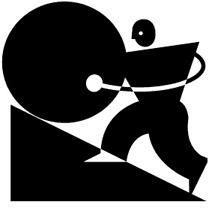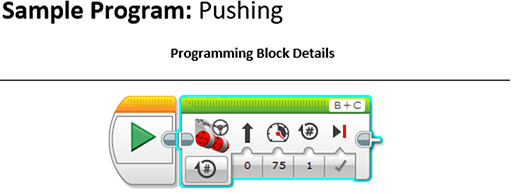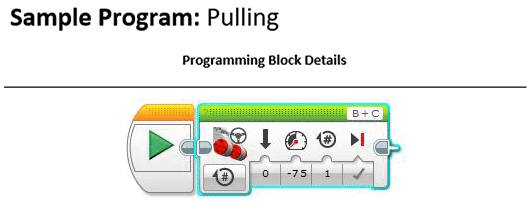Quick Look
Grade Level: 2 (1-3)
Time Required: 45 minutes
Expendable Cost/Group: US $0.00 This activity requires the use of non-expendable (and highly reusable) LEGO MINDSTORMS kits that contain sensors and other supplies; see the Materials List for details.
Group Size: 2
Activity Dependency: None
Subject Areas: Problem Solving, Science and Technology
NGSS Performance Expectations:

| 3-PS2-1 |
| K-PS2-1 |
Summary
Students develop an understanding of the concepts of "push" and "pull" as they "save" stuffed animals from danger using LEGO® MINDSTORMS® EV3 robots. After learning more about the concepts through a robot demonstration, students explore the concepts themselves in the context of saving stuffed animals from the table edges. They choose to either push or pull the animal to safety, depending on the orientation of the robot and toy. They see the consequences of their choices, learning the importance of understanding these force concepts and the differences between them.
Engineering Connection
Experiencing the practical application of "push" and "pull" forces establishes a basic understanding of how forces affect objects and their motions—fundamental concepts used in all engineering fields. For example, engineers who design automotive safety features must fully understand the forces of push and pull as they design vehicles to keep passengers safe at high speeds and in violent impacts. In the event of a crash, a seatbelt resists the push of a person against it so that the passenger does not go through the window!
Learning Objectives
After this lesson, students should be able to:
- Define the terms "push" and "pull."
- Apply the concepts of "push" and "pull."
- Use EV3 robots to help illustrate the concepts of "push" and pull."
Educational Standards
Each TeachEngineering lesson or activity is correlated to one or more K-12 science,
technology, engineering or math (STEM) educational standards.
All 100,000+ K-12 STEM standards covered in TeachEngineering are collected, maintained and packaged by the Achievement Standards Network (ASN),
a project of D2L (www.achievementstandards.org).
In the ASN, standards are hierarchically structured: first by source; e.g., by state; within source by type; e.g., science or mathematics;
within type by subtype, then by grade, etc.
Each TeachEngineering lesson or activity is correlated to one or more K-12 science, technology, engineering or math (STEM) educational standards.
All 100,000+ K-12 STEM standards covered in TeachEngineering are collected, maintained and packaged by the Achievement Standards Network (ASN), a project of D2L (www.achievementstandards.org).
In the ASN, standards are hierarchically structured: first by source; e.g., by state; within source by type; e.g., science or mathematics; within type by subtype, then by grade, etc.
NGSS: Next Generation Science Standards - Science
| NGSS Performance Expectation | ||
|---|---|---|
|
3-PS2-1. Plan and conduct an investigation to provide evidence of the effects of balanced and unbalanced forces on the motion of an object. (Grade 3) Do you agree with this alignment? |
||
| Click to view other curriculum aligned to this Performance Expectation | ||
| This activity focuses on the following Three Dimensional Learning aspects of NGSS: | ||
| Science & Engineering Practices | Disciplinary Core Ideas | Crosscutting Concepts |
| Plan and conduct an investigation collaboratively to produce data to serve as the basis for evidence, using fair tests in which variables are controlled and the number of trials considered. Alignment agreement: Science investigations use a variety of methods, tools, and techniques.Alignment agreement: | Each force acts on one particular object and has both strength and a direction. An object at rest typically has multiple forces acting on it, but they add to give zero net force on the object. Forces that do not sum to zero can cause changes in the object's speed or direction of motion. (Boundary: Qualitative and conceptual, but not quantitative addition of forces are used at this level.) Alignment agreement: Objects in contact exert forces on each other.Alignment agreement: | Cause and effect relationships are routinely identified. Alignment agreement: |
| NGSS Performance Expectation | ||
|---|---|---|
|
K-PS2-1. Plan and conduct an investigation to compare the effects of different strengths or different directions of pushes and pulls on the motion of an object. (Grade K) Do you agree with this alignment? |
||
| Click to view other curriculum aligned to this Performance Expectation | ||
| This activity focuses on the following Three Dimensional Learning aspects of NGSS: | ||
| Science & Engineering Practices | Disciplinary Core Ideas | Crosscutting Concepts |
| With guidance, plan and conduct an investigation in collaboration with peers. Alignment agreement: Scientists use different ways to study the world.Alignment agreement: | Pushes and pulls can have different strengths and directions. Alignment agreement: Pushing or pulling on an object can change the speed or direction of its motion and can start or stop it.Alignment agreement: When objects touch or collide, they push on one another and can change motion.Alignment agreement: A bigger push or pull makes things speed up or slow down more quickly.Alignment agreement: | Simple tests can be designed to gather evidence to support or refute student ideas about causes. Alignment agreement: |
International Technology and Engineering Educators Association - Technology
-
Asking questions and making observations helps a person to figure out how things work.
(Grades
K -
2)
More Details
Do you agree with this alignment?
State Standards
New York - Science
-
Plan and conduct an investigation to compare the effects of different strengths or different directions of pushes and pulls on the motion of an object.
(Grade
K)
More Details
Do you agree with this alignment?
-
Plan and conduct an investigation to provide evidence of the effects of balanced and unbalanced forces on the motion of an object.
(Grade
3)
More Details
Do you agree with this alignment?
Materials List
Each group needs:
- 1 EV3 basic robot (Note: LEGO MINDSTORMS EV3 robot, such as EV3 Core Set (5003400) at https://education.lego.com/en-us/products/lego-mindstorms-education-ev3-core-set/5003400#lego-mindstorms-education-ev3; instructions to build and program a basic robot are included with the robot kit; a sample program for "pushing" and "pulling" is attached to this activity; if not enough robots are available for one per group, share among several groups or the class by taking turns with the robot.)
- 1 stuffed animal
- string or yarn to make a secure loop around the stuffed animal, and a hook (make one by bending a paper clip) (Note: This is to attach to the robot so the robot can pull the stuffed animal.)
- Pre-Activity Content Assessment, one per student
- Post-Activity Content Assessment, one per student
Note: This activity can also be conducted with the older (and no longer sold) LEGO MINDSTORMS NXT set instead of EV3; see below for those supplies:
- LEGO MINDSTORMS NXT robot, such as EV3 Base Set
Worksheets and Attachments
Visit [www.teachengineering.org/activities/view/nyu_pushpull_activity1] to print or download.Pre-Req Knowledge
Basic familiarity with EV3 robots and EV3 robot programming
Introduction/Motivation
Discussion & Lecture with Students
Force is a very important concept in science and engineering. Two common examples of force that you may have heard of are "pushing" and "pulling." Raise your hand if you have heard of these words before. (Observe students raising their hands.)
Great! Now, raise your hand if you can either tell me or show me what "pushing" means?
(Select students to state or demonstrate their definition until a correct definition and demonstration have been given. Then emphasize this correct definition by repeating it, and demonstrating it visually. For example, move your arms in front of yourself, and mimic pushing forward with great difficulty. Ask students to confirm that you are pushing. Repeat this as necessary until students understand the concept of pushing.)
Wonderful. Now, raise your hand if you can either tell me or show me what "pulling" means? (Select students to state or demonstrate their definition until a correct definition and demonstration have been given. Then emphasize this correct definition by repeating it, and demonstrating it visually. For example, move your arms in front of yourself, and mimic pulling something backwards with great difficulty. Ask students to confirm that you are pulling. Repeat this as necessary until students understand the concept of pulling.)
Fantastic! Now, who can tell or show me what the difference between pushing and pulling is? (Select students to state or demonstrate this distinction until it has been done correctly.)
Okay! Today, we're going to see how important it is to know these words, and the difference between them! We're going to help save a cute stuffed animal from falling off a table, by either choosing to push or pull the stuffed animal to safety. Better still, we're going to use a robot to carry out our decision! Our robot has been programmed to either push a certain distance, or pull a certain distance. Once we attach our stuffed animal to our robot, you'll be able to decide whether a push or a pull would be the best choice to bring the animal to safety. Would you like to meet our robot and our stuffed animal? (Wait for response, then display each.)
I'm going to show you an example of how this robot can push and pull our stuffed animal, so you can see how easy it is! (Briefly demonstrate pushing the stuffed animal with the robot, and pulling the stuffed animal with the robot.)
We want to try our best to keep our stuffed animal from falling off the table by either pushing or pulling it to safety, but don't be too upset if during the course of today's activity it does fall. The stuffed animal won't be hurt, and I'm sure if it thought about the important concept you're learning, it would understand. Are we ready to start? Great!
Procedure
Background
During the activity, students observe a series of demonstrations in which the robot either pushes or pulls a stuffed animal. They are responsible for recognizing when the robot is pushing and when it is pulling the stuffed animal and ultimately decide whether the robot needs to push or pull the stuffed animal to safety. Have students work in pairs, and give each group a turn at each part of the activity. When one group is having its turn to program the robot, with the teacher's assistance, the other groups should be observing each demonstration and discussing what they see. If wait time between turns is any longer than five minutes, ask student groups to draw the set-up when the robot needs to push the stuffed animal and draw the set up when the robot needs to pull the stuffed animal. Require students to label their drawings and include arrows showing what direction the robot and stuffed animal will move.
Before the Activity
- Read the LEGO instructions for how to build and program a basic robot (included with the LEGO MINDSTORMS EV3 robotics kit. Then, practice programing the robot using the Sample Pushing Program (see Figure 1) and the Sample Pulling Program (see Figure 2). During the activity, help student groups to program the robot to either push or pull.

Figure 1. Screenshot of the Sample Pushing Program. 
Figure 2. Screenshot of the Sample Pulling Program. - Administer the Pre-Activity Content Assessment to students and collect when finished.
- Discuss the concepts of push and pull, as outlined in the Introduction/Motivation section.
With the Students
Part 1: Practicing Pushing and Pulling and Identification
Pushing
- Help each student group program the robot using the Sample Pushing Program.
- Have student groups place the robot behind a stuffed animal, facing toward it.
- Allow the robot to run for its distance program.
- Ask student groups whether or not the robot pushed or pulled the stuffed animal.
Pulling
- Help each student group program the robot using the Sample Pulling Program.
- Have student groups place a robot in front of a stuffed animal and attach it with a hook.
- Allow the robot to run for its distance program.
- Ask student groups whether or not the robot pushed or pulled the stuffed animal.
Teacher Mystery Choice
- Have students observe a demonstration of the robot and stuffed animal interacting.
- Ask students to decide with their partners whether or not the robot pushed or pulled the stuffed animal. Call on students to share their answers.
Part 2: Save the Stuffed Animal!
Which way to Safety?
- For each student group, set the stuffed animal and robot close to the edge of a table. Choose a slightly different position for each group.
- Ask students groups whether the robot should "push" or "pull" the stuffed animal to safety based on its position.
- Allow the robot to carry out the decision student groups made.
- Have students observe what happened to the stuffed animal. Ask them the following questions: Did it get out of danger? Or did it get into more trouble? Would you choose differently if you had to do it again?
Vocabulary/Definitions
force: Movement of an object.
pull: Moving an object toward oneself.
push: Moving an object away from oneself.
Assessment
Pre-Activity Assessment
Students complete the Pre-Activity Content Assessment to demonstrate their prior knowledge of pushing and pulling.
Activity Embedded Assessment
Circulate through the room during the activity, working with each group. By observing, helping and ask questions, assess students' understanding of the concepts of "push" and "pull."
Post-Activity Assessment
At activity end, have students complete the Post-Activity Content Assessment to demonstrate what they understand about pushing and pulling. Make a comparison to their results of the Pre-Activity Content Assessment to evaluate what students gained from the activity.
Investigating Questions
- What does "push" mean?
- What does "pull" mean?
- Can you identify pushing vs. pulling when you see examples of each?
Troubleshooting Tips
Ask students not to practice pushing or pulling on each other, because this may upset fellow classmates.
If students become restless while waiting for their turns, ask them to make drawings of the set-up, as described in the Procedure > Background section.
Activity Scaling
- For lower grades, emphasize the concepts of push and pull through demonstrations and put less emphasis on students defining the concepts in words.
- For higher grades, place greater emphasis on applications that require the use of a pushing force or a pulling force. Discuss and ask student to brainstorm different things engineers design and build that rely on a firm understand of forces.
Subscribe
Get the inside scoop on all things TeachEngineering such as new site features, curriculum updates, video releases, and more by signing up for our newsletter!Copyright
© 2012 by Regents of the University of Colorado; original © 2012 Polytechnic Institute of New York UniversityContributors
Ursula Koniges; Monique MooreSupporting Program
AMPS GK-12 Program, Polytechnic Institute of New York UniversityAcknowledgements
This activity was developed by the Applying Mechatronics to Promote Science (AMPS) Program funded by National Science Foundation GK-12 grant no. 0741714. However, these contents do not necessarily represent the policies of the NSF, and you should not assume endorsement by the federal government.
Last modified: October 16, 2020





User Comments & Tips